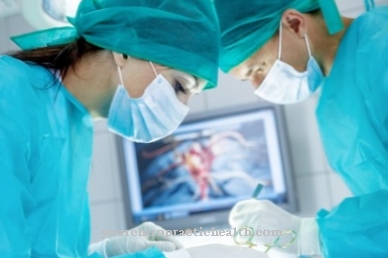The Vagotomy is the surgical severing of branches of the vagus nerve that supply the secreting cells of the stomach or duodenum. The operation is mainly used in patients with gastric and duodenal ulcers, as such ulcers are due to excessively acidic secretion. In the meantime, conservative drug solutions have largely replaced vagotomy.
What is the vagotomy?

Around 50 out of 100,000 people suffer from a stomach ulcer. Duodenal ulcers are even four times more prevalent. This means that gastric and duodenal ulcers are among the more common diseases.
Surgical methods such as vagotomy are available to the doctor to treat these ulcers. During the operation, the surgeon cuts through various branches of the cranial nerves that are involved in supplying the stomach or duodenum. After these branches are cut, less acidic gastric secretion is produced. Although the operation is effective, it is hardly or not at all performed these days. Modern developments in medicine are responsible for this.
For the treatment of patients with gastric or duodenal ulcers, so-called proton pump inhibitors are now available, which overtake the operation in terms of effectiveness. Before the introduction of these modern therapies, vagotomy played an important role in patients with gastric or duodenal ulcers, especially in the form of selective proximal vagotomy.
Function, effect & goals
The cause of ulcers of the stomach and duodenum is a disproportion between protective factors of the gastric mucosa and HCl secretion substances, which are secreted by the parietal cells. The secretion of the cells depends on a stimulus that is realized by the vagus nerve.
The term vagotomy already indicates that the surgical procedure corresponds to an intervention on the vagus nerve. The aim of the surgery is to remove or reduce the stimuli that drive the parietal cells of the stomach or duodenum to secrete. For this reason, the surgeon cuts through the branches of the nerve that supply the stomach or duodenum during the operation. Various sub-procedures with this aim are also available. Normally, on the right and left main trunk of the vagus nerve, the corresponding nerve parts are cut at different anatomical levels. In this context, a thoracic vagotomy is always used when the main nerve trunks are severed in the area of the thorax.
In the truncus form of vagotomy, the main trunks in the vagalis trunk are divided anteriorly and posteriorly from the abdomen in the region of the lower esophagus. The gastric vagotomy is based on a nerve cutting of the nerve parts that pull towards the stomach. The nerve branches to the liver and other organs are preserved. Selectively proximal vagotomy is also known as parietal cell vagotomy and is one of the most common vagotomies performed in the past.
In this procedure, the nerve branches to the stomach are severed while preserving the nerve parts that lead to the stomach gate, the so-called pylorus. This process goes back to N. Latarjet. Vagotomies always take place in an inpatient setting and require careful preparation for the operation and the patient's education. In the meantime, however, the proximally selective vagotomy hardly takes place at all.
Risks, side effects & dangers
Vagotomy is associated with general and specific surgical risks. The general surgical risks include, for example, bleeding during or after the operation, which in the worst case can lead to death.
In addition, operations are always associated with the risk of infection and, in extreme cases, can result in tissue necrosis or fatal sepsis. In addition, there is a certain risk associated with anesthesia with every operation. This risk mainly affects circulatory and overweight patients. Circulatory shock can develop during surgery in response to the anesthetic and lead to cardiac arrest. In addition, many patients feel nauseated or vomit from anesthetics. Allergic reactions to the anesthetic may also be possible.
Even more frequently, patients complain of sore throats, hoarseness and difficulty swallowing after an operation, which can occur as a reaction to artificial ventilation during an operation. Although the risk for the described complications and side effects can usually be assessed as low, the patient must be informed of the risks before the operation. One of the specific risks of vagotomy is the incorrect cutting of nerve branches that are relevant to the functioning of the stomach or intestines.
The severing of false nerve branches could result in paralysis of the peristalsis and thus functionally impair digestion. When sensory nerve fibers are cut, sensory disorders can occur. Before and especially after surgery on the stomach or duodenum, special diets are also often required in order not to overload the organs immediately after the stress event. Due to the effort and the risks, the vagotomy is now rarely used. The modern alternatives are associated with less effort as well as fewer risks and side effects for the patient.
Effective secretion-inhibiting pharmaceuticals are among the most important modern solutions. These drugs can, for example, correspond to proton pump inhibitors or H2 blockers. The invasive method of vagotomy was therefore replaced by conservative drug solutions in order not to burden the patient inappropriately. In exceptional cases, the vagotomy still takes place, mainly in the case of treatment-resistant, severe forms.



























